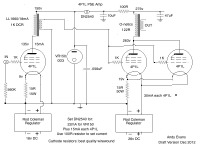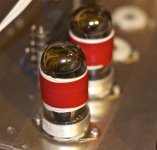Hi Andy,
Thanks for your input. Where did you get the Onetics and what price would be?
I tried a quad with UBT-1 1.6k and sounds good with RkCK elna( got a a THDof 1% at 3.7W right before all the higher order harmonics start to appear on the FFT), but not close to filament bias. I love the sound with filament bias. I am using the same UBT-1 forced to 3.2k ( by connecting 8ohm speaker at 4ohm output), and despite the fact that Lprimary is low (8H) sounds excellent. In this case I measured THD of 1.4% at 2W and 1.83 at 3W before clipping)
I am also trying to find a best match of the amp with a backloaded horn full range driver. I am in the process of building the enclosure for a Fostex FE166En and looking forward to use it. Right now I have a 2way Klipsch speaker 93dB which works great. However, I am sure that with full range driver there is a different experience.
Best,
Radu
Thanks for your input. Where did you get the Onetics and what price would be?
I tried a quad with UBT-1 1.6k and sounds good with RkCK elna( got a a THDof 1% at 3.7W right before all the higher order harmonics start to appear on the FFT), but not close to filament bias. I love the sound with filament bias. I am using the same UBT-1 forced to 3.2k ( by connecting 8ohm speaker at 4ohm output), and despite the fact that Lprimary is low (8H) sounds excellent. In this case I measured THD of 1.4% at 2W and 1.83 at 3W before clipping)
I am also trying to find a best match of the amp with a backloaded horn full range driver. I am in the process of building the enclosure for a Fostex FE166En and looking forward to use it. Right now I have a 2way Klipsch speaker 93dB which works great. However, I am sure that with full range driver there is a different experience.
Best,
Radu
Here's my latest schematic, using the LL1660/18mA instead of the Hammond 126C. I might change the operating point of the driver 4P1L if I used two glow tubes - could then increase the 150v voltage reg to say 180v or 210v. But it sounds very nice as it is. It's my daily amp. I actually have enough gain with a 2v DAC (ES9023) not to need a preamp, so just this. Speakers are Mark Audio Alpair 10s.
It's useful to have output tubes with a mu of around 10 or 11, after having used 2a3 and 300b previously which required 3 stages of DHTs if one wanted to avoid 2 stages with an indirectly heated driver. So now I have just the 2 stages of DHTs. Yippee! Should work fine with Fostex speakers.
It's useful to have output tubes with a mu of around 10 or 11, after having used 2a3 and 300b previously which required 3 stages of DHTs if one wanted to avoid 2 stages with an indirectly heated driver. So now I have just the 2 stages of DHTs. Yippee! Should work fine with Fostex speakers.
Attachments
Last edited:
If you're wanting to keep the common filament arrangement as it is, you could try feeding each tube with separate and in phase secondary windings from the IT. This would give some control as to idle current balance in the output pair, depending on how you reference the respective secondary grid returns. Some small value of positive voltage derived from the filament circuit itself via a pot could work.
Last edited:
180v = 0A3 + 0C3
210v = 0C3 + 0C3
225v = 0A3 + 0D3
255v = 0C3 + 0D3
300v = 0D3 + 0D3
Matching the output tubes is probably quite significant. I'll have to rig up some way of doing this - Ale has a circuit. If anyone else does, please post it!
The same value of paralleled capacitor for all combos?
The same value of paralleled capacitor for all combos?
Yes, just put the cap over both tubes.
Andy, have you tried a Zobel of approx 0.1uF and 330R instead of the 0.056u ?
I settled on this for the OA2's in my pentode drivers ( g2-k ) after some discussions with Gary Pimm a few years ago about how to kill the inductance in the VR's most effectively . I remember thinking it sounded a touch better than a single smaller cap alone.
I settled on this for the OA2's in my pentode drivers ( g2-k ) after some discussions with Gary Pimm a few years ago about how to kill the inductance in the VR's most effectively . I remember thinking it sounded a touch better than a single smaller cap alone.
Matching the output tubes is probably quite significant. I'll have to rig up some way of doing this - Ale has a circuit. If anyone else does, please post it!
As I mentioned at the beginning of this thread, I put all available tubes one by one in the same output stage, measured idle current and wrote it on the bulb by a permanent marker. Surprisingly, I found that tubes produced during period of time in several years, match pretty well.
I'm not having microphonic problems, not in the driver stage with 4P1L. I wrap the tubes in plumbers teflon tape and secure it with insulating tape. My chassis are all solid 4mm aluminium, plus I run the filaments at 600mA. Between all this it works fine. With 2v in it's pretty secure. When I was using it to amplify 0.5v it was more of a problem, so for that I was using a 26 preamp. Right now, though, I don't need that extra stage.
Attachments
LED instead of filament bias?
I measured some no-name LEDs and found that yellow ones have impedance of only 1.25 Ohm in the 16-24 mA range so with 2 parallel 10-led strings under each output 4P1L that would be only some 6-7 Ohm (12.5 || 12.5) for 20V bias if the tube draws 32 mA - even less than 15R shown in the latest schematic. Still no bypass cap and even simpler bias solution (heaters ca float and LEDs connected to the center tap)?
Here's my latest schematic, using the LL1660/18mA instead of the Hammond 126C. I might change the operating point of the driver 4P1L if I used two glow tubes - could then increase the 150v voltage reg to say 180v or 210v. But it sounds very nice as it is. It's my daily amp. I actually have enough gain with a 2v DAC (ES9023) not to need a preamp, so just this. Speakers are Mark Audio Alpair 10s.
It's useful to have output tubes with a mu of around 10 or 11, after having used 2a3 and 300b previously which required 3 stages of DHTs if one wanted to avoid 2 stages with an indirectly heated driver. So now I have just the 2 stages of DHTs. Yippee! Should work fine with Fostex speakers.
I measured some no-name LEDs and found that yellow ones have impedance of only 1.25 Ohm in the 16-24 mA range so with 2 parallel 10-led strings under each output 4P1L that would be only some 6-7 Ohm (12.5 || 12.5) for 20V bias if the tube draws 32 mA - even less than 15R shown in the latest schematic. Still no bypass cap and even simpler bias solution (heaters ca float and LEDs connected to the center tap)?
- Home
- Amplifiers
- Tubes / Valves
- One more 4P1L SE


